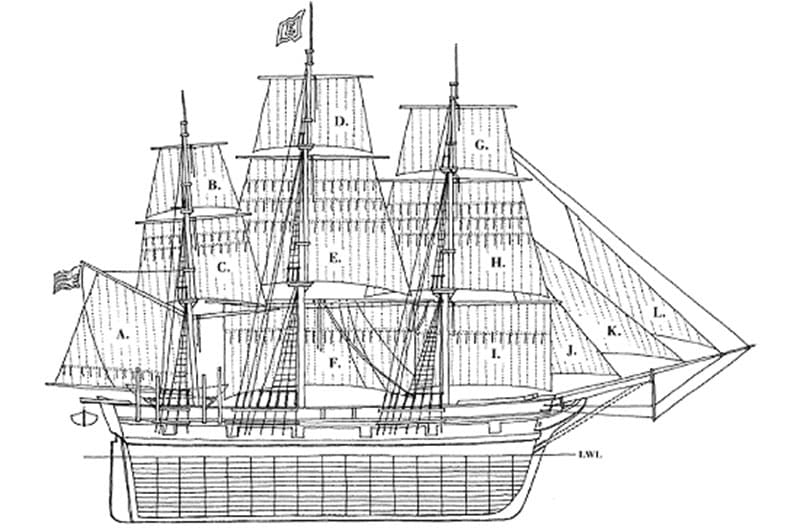by Amy Jenness, author of On This Day in Nantucket History, available at Mitchell’s Book Corner
Built in 1818 in Middletown, CT, the 340 ton Nantucket whaleship Planter left Nantucket on its first voyage on September 25 of that same year. Launched at a time when Nantucket whaleship owners were transforming the whaleships into floating factories and sending them on three year journeys to the Pacific Ocean, the Planter was one of 42 Nantucket whaleships that left port in 1818. Of those, six were brand new and 22 sailed south for the treacherous journey around Cape Horn and into the Pacific.
In 1789, first mate Archaelus Hammond, a Nantucket mariner on the English whaleship Amelia, became the first westerner to successfully harpoon a whale in the Pacific Ocean and unwittingly started a new chapter in whaling history. Within 30 years, thousands of men on board hundreds of whale ships fished in 15 areas of the Pacific Ocean. Nantucket whalers spent as much time at ports in Chile, the Sandwich Islands (now Hawaii), New Zealand, and Tahiti as they did at home.
First owned and managed by the Coffin family, the Planter successfully navigated the many perils of the sea for decades. It went aground during a storm on Nantucket in 1841; in 1844, second mate Andrew Brock and two men drowned after their boat capsized; and the crew left its captain on a Micronesian island in 1850 following a murderous mutiny—but all in all the Planter was lucky ship until October 26, 1859 when an arsonist torched and destroyed her while dry-docked in the Brant Point shipyard.
On its second-to-last voyage in 1850 the Planter crew left Captain Issac B. Hussey in Micronesia after he shot and killed a crewmember during a mutiny. Captain and crew had departed Nantucket in 1847 and three years later a few rebellious crewmembers threw a cask of beef overboard to express their unhappiness with being served spoiled food. Captain Hussey announced that no more beef would be served until those who committed the act came forward. Then the same crewmembers refused to work. As his nephew recalled years later, Captain Hussey was decisive, he shot William Clark, one of the main ringleaders, in the head. The mutiny ended and the 300 Pacific islanders traveling with them were so frightened they jumped overboard.
The crew left Captain Hussey in Micronesia, while Joseph Fisher, the first mate, sailed the Planter home. Paddock was instructed to return with the captain’s wife, but when he reached Nantucket he learned that Mrs. Hussey had died and decided to stay put. Captain Hussey, meanwhile, remained in the South Pacific.
Back home in the United States, first mate Fisher was charged with aiding Captain Hussey with the murder of William Clark. In July of 1851 Bostonbased U.S. Commissioner George S Hilliard dismissed the charges against Fisher, saying the crewman had acted with insubordination and Captain Hussey committed no crime in ending the escalating mutiny and taking back control of his ship.
Finally in 1852, Captain Hussey left Micronesia in command of the San Francisco brig William Penn and headed for America. While off the Gilbert Islands, that crew mutinied and killed Hussey and the ship’s cook on November 6th. The mutineers stole everything on the boat, left, and never were apprehended. The wounded ship’s mates buried Hussey and the cook at sea.
The Planter sailed from Nantucket to the Pacific one last time in 1852. By that time Nantucket had lost its domination of the whaling industry for multiple reasons: a devastating 1846 fire that destroyed the downtown, docks, and many ships; the loss of men and vessels to the Gold Rush in California; and shifting sands which created a sand bar at the entrance to the harbor and made ship passage difficult. On her last voyage, 34 years after her launch, the Planter was one of only 13 whaleships ships to set out that year—six of them would be sold or destroyed before returning home. When the Planter returned in 1856 she was pulled out of the water for repairs to her hull.
While dry-docked for those repairs at a Brant Point shipyard, the Planter was completely destroyed by fire on October 26, 1859. Nantucket firefighters thought they had limited the blaze to the stern, but then flames began emerge from the forward hatches and it was clear the Planter was a total loss.
In order to save surrounding buildings, firefighters removed the ship supports on the east side and let it fall away from the vulnerable property. “The ship careened slowly and gracefully on her side. While the flames, fanned by the breeze, spread wildly over her, presenting a grand spectacle. The ship continued to burn until she was completely consumed, nothing remained save the copper and iron fastenings and one or two large timbers; and the spot where a few hours before stood one of the best modeled and fastest sailing whalers hailing from this port, was covered with a mass of smouldering ruins,” said an article in The Inquirer.
The newspaper noted that a suspicious person had been seen leaving the shipyard shortly before the fire was discovered, and that, along with another suspicious fire in the area, lead the paper to conclude, “The fire was probably the work of an incendiary.”

